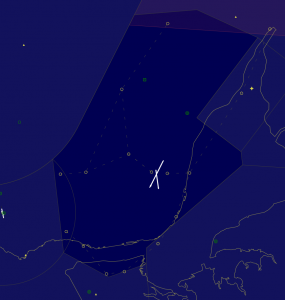Airspace Characteristics
Lisboa CTR is a Class C, extending from Surface to 2000 ft, within a defined rectangular-like shape as shown on the picture below, excluding the portion of airspace on North by the Restriced Area LPR43C and on the south-west part by Cascais, when either of those are Active.
The aerodrome transition altitude is 4000 ft, and transition level is in function of QHN.
Runway configuration
Preferred runway is 03 for departure and arrival.
In case of low visibility below the minimums for ILS CAT I, runway 21 will be in force due being the only runway with ILS CAT III procedures, regardless of wind component.
Runway 35 should only be used when required for safety reasons (i.e. crosswind or windshear on RWY 03) and not for convenience, time or fuel saving.
Runway 17 should only be used for departures.
Runway 03 approach can be done using ILS CAT I, LOC, RNAV, VOR, NDB or Visual.
Runway 21 approach can be done using ILS CAT I/II/III, LOC, RNAV, VOR or Locator.
Runway 35 approach can be done using VOR or Visual.
Runway 17 can, when required, be used for arrivals by aircraft with approach guidance requirements less demanding than turbojet and other aircraft of similar approach guidance requirements and the approach shall be performed visually.
Significant VFR Points and Areas
- Farol do Bugio – 38º39’32’’ N 009º17’51’’ W
- Algés / Doca de Pesca de Pedrouços – 38º 41’ 31’’ N 009º13’48’’ W
- Mata de Queluz – 38º44’33’’ N 009º15’31’’ W
These significant waypoints are to be used by VFR traffic inside Lisboa CTR, if the ATC needs them to Vacate or Hold Visually due incoming IFR traffic, or other situations as applicable.
Farol do Bugio and Algés must be reached at an altitude of 500 ft. Mata de Queluz must only be used by helicopters in stationary flight at an altitude of 1000 ft, with visibility equal or greater than 10KM and ceiling shall be at most scattered at or above 3000 ft.
Special VRP for Helicopters Procedures
When arriving or departing Lisboa Airport, the following Entry/Exit points are to be used:
- Igreja das Galinheiras – 38º47’00’’ N 009º08’36’’ W
- Ralis – 38º46’59’’ N 009º07’13’’ W
Helicopters shall preferably use runway 17/35.
Additionally, on our virtual Environment, the following VRP can be used for VFR Traffic, especially upon arrival of an IFR traffic:
- Odivelas – 8º48’07’’ N 009º10’42’’ W
- Parque das Nações – 38º46’06’’ N 009º05’38’’ W
Local Procedures
When runway 03 is in use, departure positions M and N are to be considered the same in terms of wake turbulence separation. Position P can also be used for departures, mainly for small jets and turbo-prop airplanes.
When runway 21 is in use, position U will be the preferred position for all aircraft expect Heavy Jets.
If a pilot requires full length runway he shall advise the ATC upon requesting start-up clearance.
When a pilot calls for departure clearance, ATC clearance must include:
- aircraft identification
- clearance limit, normally destination aerodrome
- designator of the assigned SID, if applicable. When receiving the designator of the assigned SID, pilots shall comply with the published SID vertical profile
- any other necessary instructions or information not contained in the SID description, if needed
Allocated SSR code will only be transmitted on Push-back and/or Start-up Clearance
After take-off pilots are expected to contact Lisboa Approach when passing 1000FT QNH, without any hand-off procedure, unless otherwise instructed by Lisboa Tower. On the departure pilots first contact shall contain only the Callsign and Altitude.
When arriving, pilots first contact with Lisboa Terminal Control shall contain Callsign, Cleared Flight Level and STAR and/or Cleared Waypoint
Runway 03/21 have high speed turn off exists that pilots must make use of compulsorily. If unable, pilot shall advise ATC. Requests to vacate via other exits, for example runway 17 or via S1 when landing on RWY03, may be done to Tower controller as soon as practicable.
The tower controller will be the one responsible to manage the active runway and ensure that the ATIS information of the Ground and Delivery controllers is correct. In the absence of the Tower, Ground assumes that role, and ultimately, delivery controller acts alone.
ATIS Information shall contain only relevant information, such as METAR Information, Transition Altitude, Transition Level, Departure Runway, Arrival Runway, Airborne frequency and ATIS Designator.
The Airborne frequency shall be coordinated with Lisboa Approach or Lisboa Control, if available, and inserted on the ATIS Remarks field as follows: “After Departure Contact 119.1”. If no station is available, the ATC shall insert “After Departure Monitor 122.8”.
Phraseology examples
For the VFR purpose, Pilot will be flying a C152 with registration CS-AVC and we will assume both Ground and Tower positions are active. Runway in use is 03.
Traffic for Local Patterns
CSAVC – Lisboa Ground, bom dia, CSAVC at apron A request start-up
GND – CSAVC, bom dia, start-up approved, runway 03 in use, wind 320 at 10, QNH 1020
CSAVC – start-up approved, runway 03, QNH 1020, CSAVC
—
CSAVC – Ground, CSAVC ready to copy for local circuits, and request taxi
GND – CVC, cleared from Lisboa to Lisboa, after departure turn left join downwind runway 03, 1000 feet
CSAVC – cleared from Lisboa to Lisboa, after departure turn left join downwind runway 03, 1000 feet, CVC
GND – CVC readback correct, taxi holding point runway 03
CSAVC – taxi holding point runway 03, CVC
—
CSAVC – Ground, CVC reaching holding point runway 03
GND – CVC contact Lisboa Tower on 118.1, bom dia
CSAVC – Contacting Tower 118.1, CVC obrigado
—-
CSAVC – Lisboa Tower, bom dia, CSAVC at holding point runway 03 ready for departure
TWR – CSAVC, bom dia, wind 320 at 10, runway 03 cleared for take off
CSAVC – runway 03, cleared for takeoff CSAVC
After that, it’s business as usual, with the pilot reporting on downwind the intention for next approach / touch-and-go, stop-and-go, full stop, low pass etc….
IFR Traffic Departing
For the IFR purpose, Pilot will be flying an A320 with callsign Air Portugal 9342 and we will assume Delivery, Ground and Tower positions are active. Runway in use is 03 and current ATIS information is R.
—
TAP9342 – Lisboa Delivery, bom dia, Air Portugal 9342, stand 115 with information Romeo, request clearance to Sevilla, initial cruise FL270
DEL – Air Portugal 9342 bom dia, information Romeo current, QNH 1018, cleared from Lisboa to Sevilla via GAIOS4N departure runway 03
TAP9342 – Cleared from Lisboa to Sevilla via GAIOS4N departure runway 03, Air Portugal 9342
DEL – Air Portugal 9342, readback correct
— please note that normally no frequency change is to be done at this point, pilot changes to GND frequency by own initiative –
TAP9342 – Lisboa Ground, bom dia, Air Portugal 9342, stand 115 request push-back and start-up
GND – Air Portugal 9342, bom dia, push back and start-up approved, squawk 4271
TAP9342 – Push back and start-up approved, squawk 4271 Air Portugal 9342
…
TAP9342 – Ground, request taxi Air Portugal 9342
GND – Air Portugal 9342 taxi to holding point N2 via A and M, cross runway 35
TAP9342 – Taxi to holding point N2 via A and M crossing runway 35, Air Portugal 9342
—
TAP9342 – Ground, reaching holding point, Air Portugal 9342
This first transmission can be omitted, as the ground controller can view the aircraft reaching the holding point and transfer it to tower. GND –
GND – Air Portugal 9342 contact Lisboa Tower on 118.1, bom voo
TAP9342 – Tower on 118.1, obrigado, Air Portugal 9342
—
TAP9342 – Lisboa Tower, bom dia, Air Portugal 9342 on holding point N2 ready for departure
There are three options now that can be used:
If a traffic is inbound to land.
TWR – Air Portugal 9342, bom dia, hold short runway 03
TAP9342 – Holding short, Air Portugal 9342
If the landing traffic is on short-final,
TWR – Air Portugal 9342, behind A320 on short-final line up and wait behind
TAP9342 – Behind the A320 on short-final line up and wait behind, Air Portugal 9342
If there is no traffic landing and departure clearance can be given:
TWR – Air Portugal 9342 wind 310 degrees at 15 knots, cleared for takeoff runway 03, bom voo
TAP9342 – Cleared for takeoff runway 03, bom serviço


